 Image search results - "lodge" Image search results - "lodge" |

Yaito Matsuri sign
|
|
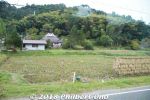
This is a farmhouse lodge (農家民宿) where we stayed in the city of Ayabe. It fronts rice paddies. The farmhouse lodge owner can pick you up at JR Ayabe Station.
|
|

Farmhouse lodge (農家民宿) named Pokapoka Noen. It has two main buildings.
|
|
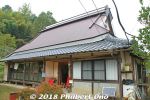
This is the main lodge where the kitchen, dining, and bath facilities are. It also has one guest room with twin beds. It is a traditional farmhouse with a thatched roof protected by a corrugated tin.Farm house in Ayabe, Kyoto Prefecture.
|
|
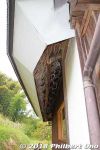
Uner the corrugated tin, you can see the thatched roof edge.
|
|
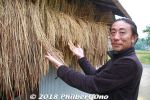
The 42-year-old owner, Kushida Kampei (櫛田寒平) moved to Ayabe from Tokyo seven years ago. He has his own rice paddies and other plots to grow his own rice and vegetables.
|
|
|
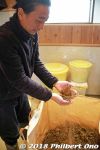
He also grows sesame seeds.
|
|
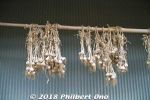
Garlic.
|
|
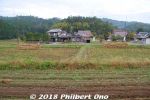
His rice paddies.
|
|
|
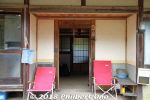
Entrance to the main lodge.
|
|
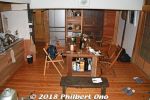
Kitchen and dining room. Totally renovated and modern on the inside, with a modern kitchen, toilet, and bath.
|
|
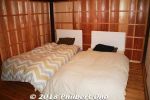
Guest room with twin beds.
|
|
|
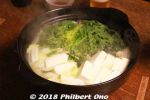
Our dinner included the rice and vegetables that he grew. (This was just the first serving.) It cost only ¥7,000 per night including dinner and breakfast.
|
|
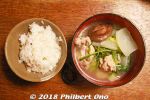
This was just the first serving.
|
|
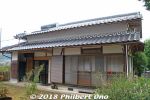
The other building was the guest house which was originally for the farmer's kids or relatives to stay when they returned to their hometown.
|
|
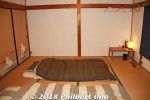
The guest room in the guest house was Japanese-style with twin futon.
|
|
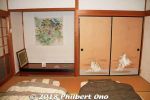
Very nice guest room.
|
|
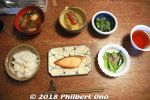
Breakfast.
|
|

The Honjin was the town's most exclusive lodge reserved for daimyo lords, government officials, and even Emperor Meiji. Each post town on the Tokaido had a Honjin.
|
|

The Tsuchiyama-juku Honjin opened in 1634 on the occasion of Shogun Tokugawa Iemitsu staying here on his way to Kyoto. The Tsuchiyama family was appointed as the Honjin's caretaker.
|
|

Inside the side entrance of the Tsuchiyama-juku Honjin. If you want to see inside the Honjin, call to make reservations. Admission 300 yen. Phone: 0748-66-0007 (English not spoken)
|
|

The entrance is decorated with wooden signs (sekifuda 関札) of the VIPs who stayed here. Whenever a VIP stayed here, the wooden sign with his name on it would be displayed on the gate.
|
|

The Hosokawa daimyo from Kumamoto stayed here quite a few times. When a daimyo was lodging at the Honjin, passers by were required to get off their horses while walking past the Honjin as a gesture of respect.
|
|

The Tsuchiyama-juku Honjin operated until 1870 when the shukuba system was abolished. For over three centuries, the Tsuchiyamas took care of the Honjin. Their 15th-generation descendants live here now and take care of it as a tourist attraction.
|
|

This dirt-floored entryway dates from the Edo Period. It's slightly bumpy and packed hard with a glossy black color. It definitely looks centuries old. Was happy to touch some earth of the Edo Period.
|
|

A short walk through the long Honjin brought me to the Jodan-no-Ma (Upper Class Room) where the shoguns, daimyo lords, and Emperor Meiji stayed. 上段の間
|
|

The Jodan-no-Ma has elevated tatami mats on which the VIP sat and slept. This is called the Gyokuza. The room size is 8 tatami mats. Tsuchiyama Honjin address: 滋賀県甲賀市土山町北土山1628 玉座
|
|

Honjin guest books signed by all the shoguns, daimyos, and other VIPs who stayed here. All of the guest books since the 17th century have been preserved.
|
|

This lists the dates when members of the Imperial Family lodged here. Emperor Meiji came here three times. The first time was on Nov. 3, 1868 when he lodged overnight and celebrated his birthday. The next two times, he only took a break here.
|
|

The Honjin's garden has a stone monument indicating that Emperor Meiji stayed here. It was during the first year of the Meiji Period when he stayed here, and it was in Tsuchiyama when he celebrated his first birthday during the Meiji Period.
|
|

To celebrate his birthday, Emperor Meiji gave sake and dried squid to all the families in Tsuchiyama. The Honjin's Tsuchiyama family went to great lengths to prepare for the Imperial stopover. Besides renovating the house, they dug a new water well.
|
|

Page from the Honjin's guest book. Shogun Tokugawa Yoshinobu, the last shogun, also lodged here and signed the guest book. Saigo Takamori also stayed here.
|
|

Room next to the Jodan-no-Ma. The Honjin has numerous rooms. This is one of the very few original Honjin remaining in Japan. There's another one in Shiga in Kusatsu.
|
|

Tsuchiyama-juku on the old Tokaido Road. On the right is the site of the Waki Honjin which is near the Honjin. If no VIPs were staying at the Waki Honjin, ordinary travelers could also stay here if they had the money. This building is not original.
|
|

Site of the Waki Honjin, used as a secondary Honjin when the Honjin was already occupied. If two daimyo lords were staying in town at the same time, the higher-ranked lord would stay at the Honjin. 脇本陣
|
|
|
|
|
|